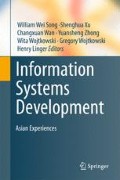Abstract
China’s express delivery market has become the arena in which each express enterprise struggles to chase due to the huge potential demand and high profitable prospects. So certain qualitative and quantitative forecast for the future changes of China’s express delivery market will help enterprises understand various types of market conditions and social changes in demand and adjust business activities to enhance their competitiveness timely. The development of China’s express delivery industry is first introduced in this chapter. Then the theoretical basis of the regression model is overviewed. We also predict the demand trends of China’s express delivery market by using Pearson correlation analysis and regression analysis from qualitative and quantitative aspects, respectively. Finally, we draw some conclusions and recommendations for China’s express delivery industry.
Access this chapter
Tax calculation will be finalised at checkout
Purchases are for personal use only
References
Li Qian, Lv Li Ping, and Yan Jing Dong (2008) China’s express industry industry analysis.Business Economics 8: 110–111.
Chen Shi Yang (2007) Express industry in our country the status quo and countermeasures. China Water Transport 9: 194–195.
Henderson C. R. (1950) Estimation of genetic parameters. The Annals of Mathematical Statistics 21: 309–310.
Rao C. R. (1976) Estimation of parameters in a linear model. The Annals of Statistics 4: 1023–1037.
Kees Jan van Garderen (2001) Optimal prediction in loglinear models. Journal of Econometrics 104: 119–140.
Royall R. M. (1970) On finite population sampling theory under certain linear regression models. Biometrika 57: 377–387.
Royall R. M. and Herson J. H. (1973) Robust estimation in finite populations. American Statistical Association 68: 880–889.
Pereira C. A. B., and Rodrigues J. (1983) Robust linear prediction in finite populations. International Statistical Review 51: 293–300.
Yoshikazu Takada (1981) Relation of the best invariant prediction and the best unbiased prediction location and scale families. The Annals of Statistics 9: 917–921.
Gauri Sankar Datta, and Malay Ghosh (1991) Bayesian prediction in linear models: Applications to small area estimation. The Annals of Statistics 19: 1748–1770.
Richard M. Royall, and Dany Pfeffermann (1982) Balanced samples and robust Bayesian inference in finite population sampling. Biometrika 69: 401–409.
C. Radhakrishna Rao (1987) Prediction of future observations in growth curve models. Statistical Science 4: 434–471.
Leung M. T., Chen A. S., and Daouk H. (2000) Forecasting exchange rates using general regression neural networks. Computers & Operations Research 27: 1093–1110.
Christiaan Heij, Patrick J. F. Groenen, and Dick van Dijk (2007) Forecast comparison of principal component regression and principal covariate regression. Computational Statistics & Data Analysis 51: 3612–3625.
Syed Shahabuddin (2009) Forecasting automobile sales. Management Research News 7: 32–42.
Yu Jian Ying, and He Xu Hong (2006) SPSS Statistical Data Analysis and Application, pp. 194–196. Beijing: Posts & Telecommunications Press (in Chinese).
National Bureau of Statistics of China (2008) China Statistical Yearbook 2007, pp. 210–252. Beijing: China Statistics Press (in Chinese).
Acknowledgments
It is a project supported by philosophy and social science in Zhejiang Province (07CGLJ018YBX), the results of Center for Research in Modern Business, Zhejiang Gongshang University (the important research base for high school social and science of High Education Department), and the normal project of philosophy and social science in Hangzhou (D07GL07).
Author information
Authors and Affiliations
Corresponding author
Editor information
Editors and Affiliations
Rights and permissions
Copyright information
© 2011 Springer Science+Business Media, LLC
About this paper
Cite this paper
Jiang, C., Bai, L., Tong, X. (2011). Analysis of Market Opportunities for Chinese Private Express Delivery Industry. In: Song, W., et al. Information Systems Development. Springer, New York, NY. https://doi.org/10.1007/978-1-4419-7355-9_33
Download citation
DOI: https://doi.org/10.1007/978-1-4419-7355-9_33
Published:
Publisher Name: Springer, New York, NY
Print ISBN: 978-1-4419-7205-7
Online ISBN: 978-1-4419-7355-9
eBook Packages: Computer ScienceComputer Science (R0)

